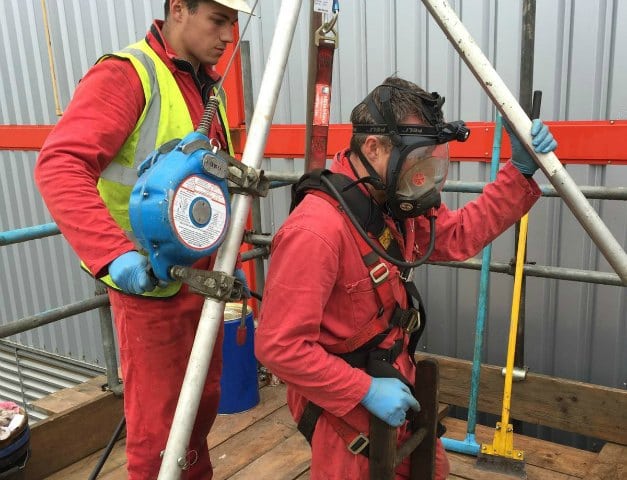This particular diesel tank cleaning project was relatively straight forward and was completed in the same day.
The tank in question was purchased by a client of ours as a used tank, and they simply wanted to ensure that the tank was perfectly clean prior to introducing diesel.
As with any enquiry we have relating to diesel tank cleaning, or any other form of tank cleaning, we needed to establish how we can safely gain access into the tank and most importantly have a means of rescue in the unlikely event of an incident in the tank. In this scenario, the tank is cylindrical, therefore requiring the erecting of a fixed scaffold to ensure safe working at height procedures are adhered to. In the event of scaffolding being required for diesel tank cleaning, the option is always given to the client to provide their own scaffold, as long as an accredited company is employed.
With a safe working platform in position, the diesel tank cleaning preparation can begin. Any equipment that cannot be raised onto the platform using a gin wheel, is lifted using our own lorry mounted crane by one of our ALLMI accredited operators, thus eliminating manual handling issues.
The lid is then removed from the tank to allow any residual liquid to be removed prior to the diesel tank cleaning process being carried out. In this case, the tank only contained a small amount of residue, however we are able to cater for a variety of situations including temporary storage of fuel, fuel testing and polishing if required.
The tank is now ready for cleaning, a confined space entry permit will be obtained and an operative prepared to enter the tank.
As you can imagine, diesel tank cleaning can be a dirty business, the picture below demonstrates the level of sludge and contamination that can be found in the bottom of a fuel tank.
Depending on where the fill pipe enters the tank, lifting the lid can be deceiving as sludge will often reside at the ends of the tank, giving the impression that the tank is relatively clean, when in reality there can be in excess of 200 kilos of sludge and water in the bottom.
Once the tank has been fully cleaned, a visual inspection of the tank internals is carried out, along with photos taken. The tank lid is then replaced with a fresh gasket and new stainless steel bolts. Our OFTEC registered engineers are able to perform a T/133ND tank inspection and if required we can organise pressure testing of the tank.
Upon completion the client is given a hazardous waste consignment note for any waste removed from site, a gas free certificate can be issued for the tank and any inspection reports generated.
To read more about our oil tank cleaning services, please click here.

